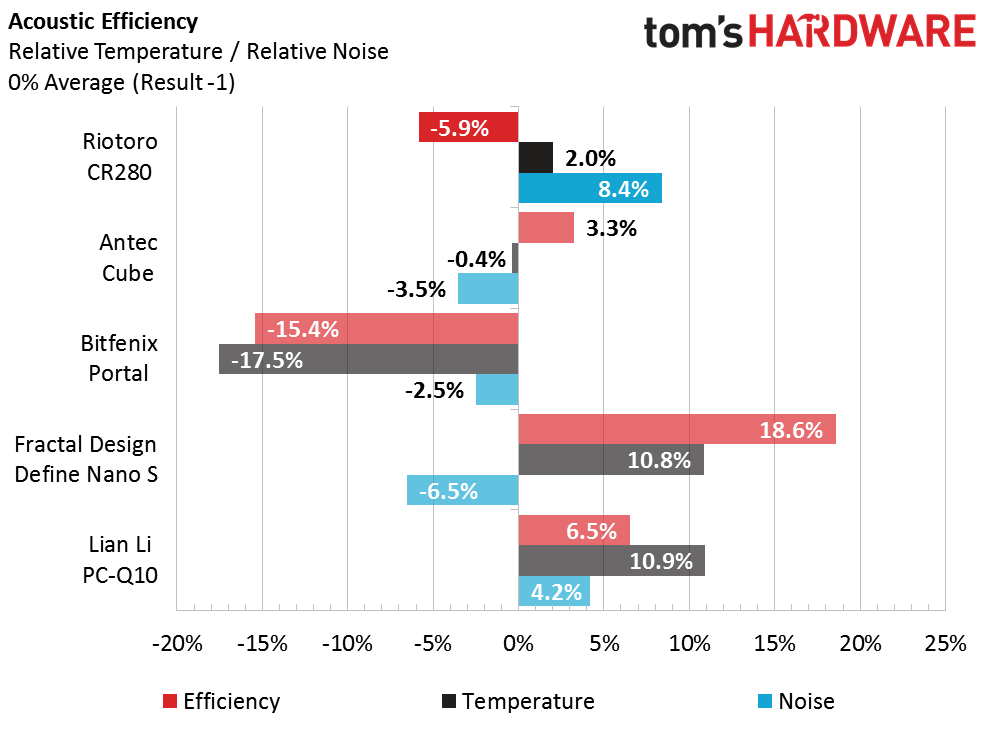Riotoro CR280 Mini ITX Case Review
Why you can trust Tom's Hardware
Benchmarks & Final Analysis
The ventilated front panel and factory-installed front and rear fans serve the CR280 well, giving it the middle of the road thermal performance that’s expected out of a $55 case. The CR280 pulls off better thermal performance than some of the more expensive cases we’ve tested at a fraction of the price.
Unfortunately, the same ventilated front panel and fans that served the CR280 well in the thermal tests also make it the second loudest case in today’s comparisons.
With only average thermal performance to balance out the poor noise performance, the CR280 also comes in second to last in our acoustic efficiency benchmark. However, as we’re about to see, the CR280 does have one major advantage over all of the other cases. We'll bet you can guess what that is.
Like the Define Nano S before it, the CR280’s $55 price tag propels it into first place, despite its average performance. Most of the other cases on the list have a price tag over $100.
The CR280 is an excellent overall value. For $55, you get a well-designed compact gaming case with plenty of room for hardware, good cooling performance, and plenty of potential for expansion. The only thing that seems to really drag the CR280 down is some of the design decisions that Riotoro made to reduce the cost of the case. Yet, we feel the inclusion of other features not normally found on a budget case offset the negatives that come from cutting corners, and with a $55 price tag we find the CR280 to be a compelling alternative to many of the more expensive compact cases on the market.
MORE: Best Cases
MORE: All Case Content
Get Tom's Hardware's best news and in-depth reviews, straight to your inbox.
-
itsmedatguy great price, but I wish some more case manufacturers would build some higher end ITX cases that are actually this compact. Lian Li seems like the best bet, but I'm not interested in spending 2-300 on a caseReply -
DarkSable I mean, this is great value, and it's a good starting point for getting into small form factor builds. You're also right that going much smaller is going to require a more optimized layout, though that's really not a drawback aside from perhaps being slightly trickier to build in the first time.Reply
However, do bear in mind that when talking about SFF as an enthusiast niche, this case really isn't that small - 320mm x 203mm x 330mm works out to 21.5 liters. The widely available Silverstone Raven is just 14 liters, and there are specialty cases which use completely off-the-shelf parts to build gaming computers in a half to a third of this case. Heck, the S4 mini comes with a custom power supply, can fit up to an itx gtx 1080, and is less than a quarter of the volume of this case.
I mean, there are people designing cases to fit full ATX computers into ~23 liters.
I've said things like this before and gotten lukewarm responses, so let me just qualify this: Yes, those are pricy solutions, and yes, it's very niche... But someone interested in a case like this, who hasn't yet found the world of SFF computing, deserves to know about it. Surely it can't hurt to add two sentences to your article saying, "I know this case is tiny compared to a regular ITX chassis, but coming at it from the other perspective, 21.5 liters makes this a somewhat sizeable case for those niche enthusiasts who are into SFF computing."
(That's another thing I'd love to see; the dimensions are a start, but giving the volume in the stats would be super nice when talking about ITX cases. It's an easy calculation, and google will do it for you if you just type in the dimensions in mm multiplied by each other.) -
shrapnel_indie Reply20009227 said:(That's another thing I'd love to see; the dimensions are a start, but giving the volume in the stats would be super nice when talking about ITX cases. It's an easy calculation, and google will do it for you if you just type in the dimensions in mm multiplied by each other.)
For that to be most effective, one has to use internal measurements and not external, which is a little harder to find. -
shrapnel_indie One positive about the "paper wrap" for a color filter on the LEDs. If you don't want red, you can change it easy enough. the red strip around the front of the case is a different matter, but if you can live with that and different colors for the LEDs...Reply -
jmcgaw I'm guessing that this thing must take some sort of drives. Or does it? Additionally, a case of this configuration might attract someone who wants a small HTPC and for that most builders would like to have an optical drive up front. Was any of this addressed in the review? I didn't see it but maybe old age is taking its toll...Reply



